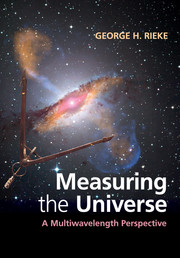Book contents
- Frontmatter
- Contents
- Preface
- 1 Radiometry, optics, statistics
- 2 Telescopes
- 3 Detectors for the ultraviolet through the infrared
- 4 Optical and infrared imaging; astrometry
- 5 Photometry and polarimetry
- 6 Spectroscopy
- 7 Adaptive optics and high-contrast imaging
- 8 Submillimeter and radio astronomy
- 9 Interferometry and aperture synthesis
- 10 X- and gamma-ray astronomy
- 11 Epilogue: cosmic rays, neutrinos, gravitational waves
- Appendix A Useful constants
- Appendix B Common Fourier transforms and relations
- References
- Index
- References
9 - Interferometry and aperture synthesis
Published online by Cambridge University Press: 05 November 2012
- Frontmatter
- Contents
- Preface
- 1 Radiometry, optics, statistics
- 2 Telescopes
- 3 Detectors for the ultraviolet through the infrared
- 4 Optical and infrared imaging; astrometry
- 5 Photometry and polarimetry
- 6 Spectroscopy
- 7 Adaptive optics and high-contrast imaging
- 8 Submillimeter and radio astronomy
- 9 Interferometry and aperture synthesis
- 10 X- and gamma-ray astronomy
- 11 Epilogue: cosmic rays, neutrinos, gravitational waves
- Appendix A Useful constants
- Appendix B Common Fourier transforms and relations
- References
- Index
- References
Summary
Introduction
The Byrd Green Bank Telescope is the largest fully steerable filled-aperture radio telescope, with a size of 100 × 110 meters. The runners-up are the Effelsberg telescope, with a diameter of 100 meters, and the Jodrell Bank Lovell Telescope, 76 meters in diameter. The collecting areas of these telescopes are awesome, but their angular resolutions are poor: at λ = 21 cm, λ/D for a 100-m telescope is about 7 arcmin. These enormous telescope structures are difficult to keep in accurate alignment and are subject to huge forces from wind. Proposals for larger telescopes (e.g., the Jodrell Bank Mark IV and V telescopes at 305 and 122 m respectively) pose major engineering challenges for modest improvements in resolution and have also proven to press the limits of what other humans are willing to purchase for astronomers. The Arecibo disk circumvents some of these issues by being fixed in the ground and pointing by moving its feed; this concept allows a diameter of 259 m. However, the dish must be spherical, limiting the optical accuracy of the telescope, and it can reach only a fraction of the sky (roughly ± 20° from the zenith). The angular resolution is still modest, a bit worse than 2 arcmin at 21 cm (1.4 GHz). This resolution is only equivalent to that of the unaided human eye!
Even if we could build larger telescopes, they would be limited by source confusion: in very deep observations, the background of distant galaxies is so complex to these relatively large beams that it becomes impossible to distinguish an object from its neighbors (see Section 1.5.4).
- Type
- Chapter
- Information
- Measuring the UniverseA Multiwavelength Perspective, pp. 266 - 292Publisher: Cambridge University PressPrint publication year: 2012



